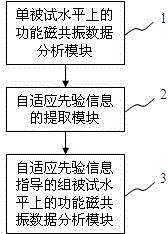Brain function connectivity detection system and method based on self-adaptive priori information guidance
A connectivity detection and prior information technology, applied in the field of blind source signal separation technology based on functional magnetic resonance imaging technology, can solve problems such as limiting detection capabilities, and achieve the effect of improving accuracy and accurately locating brain functional connectivity areas
- Summary
- Abstract
- Description
- Claims
- Application Information
AI Technical Summary
Problems solved by technology
Method used
Image
Examples
Embodiment Construction
[0033] The following combination figure 1 and figure 2 , a preferred embodiment of the present invention is described in detail.
[0034] Such as figure 1As shown, the brain functional connectivity detection system based on the guidance of adaptive prior information provided by the present invention includes: a functional magnetic resonance data analysis module 1 at the level of a single subject, which is used to collect The masks of the fMRI data of each single subject were connected, and the fMRI data of each single subject in the group were subjected to blind source signal separation using the independent component analysis method to obtain the corresponding Independent functional components; the extraction module 2 of adaptive prior information, which is connected to the functional magnetic resonance data analysis module 1 on the single subject level, and utilizes the principal component analysis method to obtain the corresponding functional components from each single ...
PUM
 Login to View More
Login to View More Abstract
Description
Claims
Application Information
 Login to View More
Login to View More - R&D
- Intellectual Property
- Life Sciences
- Materials
- Tech Scout
- Unparalleled Data Quality
- Higher Quality Content
- 60% Fewer Hallucinations
Browse by: Latest US Patents, China's latest patents, Technical Efficacy Thesaurus, Application Domain, Technology Topic, Popular Technical Reports.
© 2025 PatSnap. All rights reserved.Legal|Privacy policy|Modern Slavery Act Transparency Statement|Sitemap|About US| Contact US: help@patsnap.com


